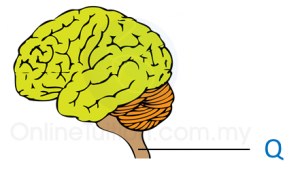Question 1:
Diagram 1.1 shows a student sitting cross-legged on a chair. A friend hits lightly below part of the student’s knee cap with a rubber hammer.
(d) Diagram 1.2 shows parts Q which controls the action in 1(b). Name part Q. [1 mark]
Answer:
(a) The student’s leg jerks upwards.
Diagram 1.1 shows a student sitting cross-legged on a chair. A friend hits lightly below part of the student’s knee cap with a rubber hammer.

Diagram 1.1
(a) What happens to the student’s leg after being hit? [1 mark]
(b) Name the type of action in 1(a). [1 mark]
(c) State one importance of the action in 1(b). [1 mark]
(d) Diagram 1.2 shows parts Q which controls the action in 1(b). Name part Q. [1 mark]
 Diagram 1.2
Diagram 1.2
(e) Diagram 1.3 shows three type of neurones.
Mark (√) in the boxes provided, the neurones involved in the action in 1(b). [2 marks]
 Diagram 1.3
Diagram 1.3
Answer:
(a) The student’s leg jerks upwards.
(b) Reflex action
(c) To avoid injury.
(d) Spinal cord
(e)
